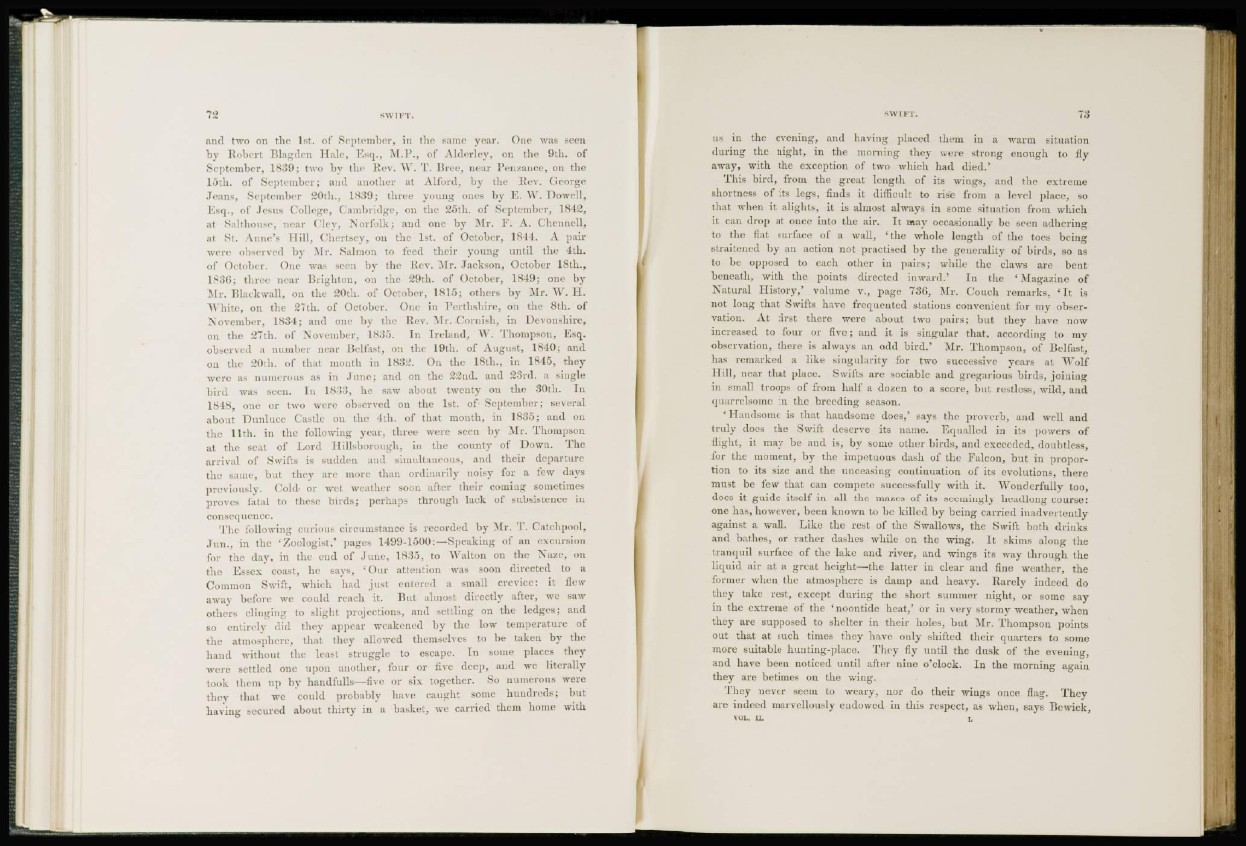
and two on the 1st. of September, in the same year. One was Been
by Robert Blagden Hale, Esq., M.P., of Alderley, on the 9th. of
September, 1839; two by the Rev. W. T. Bree, near Penzance, on the
15th. of September; and another at Alford, by the Rev. George
Jeans, September 20th., 18:i9; three young ones by E. W. Dowell,
Esq., of Jesus College, Cambridge, on the 25th. of September, 1842,
at Saltliouse, near Cley, Norfolk; and one by Mr. F. A. Chenuell,
;ii St. Anne's Hill, Chertsey, on the 1st. of October, 1844. A pahwere
observed by Mr. Salmon to feed their young until the 4th.
of October. One was seen by the llev. Mr. Jackson, October 18th.,
18;i(i: three near Brighton, on the 29th. of October, 1849; one by
Mr. Blackwall, on the 20th. of October, 1815; others by Mr. W. II.
White, on the 27th. of October. One in Perthsl lire, on the 8th. of
November, 1834; and one by the Rev. Mr. Cornish, in Devonshire,
m i the 27th, of November, 1835. In Ireland, W. Thompson, Esq.
observed a number near Belfast, on the 19th. of August, 1840; and
on the 20th. of that month in 1832. On the 18th., in 1845, they
were as numerous as in June; and on the 22nd. and 23rd. a single
bird was seen. In 1833, he saw about twenty on the 30th. In
1848, one or two were observed on the 1st. of September; several
about Dunlucc Castle ou the 4th. of that month, in 1835; and on
the 11th. in the following year, three were seen by Mr. Thompson
at the seat of Lord Hillsborough, in the county of Down. The
arrival of Swifts is sudden and simultaneous, and their departure
the same, but they are more than ordinarily noisy for a few days
previously. Cold- or wet weather soon after their coining sometimes
proves fatal to these birds; perhaps through lack of subsistence in
consequence.
The following curious circumstance is recorded by Mr. T. Catchpool,
Jnn., in the 'Zoologist,' pages 1499-1500:—Speaking of an excursion
for the day, in the end of June, 1835, to Walton on the Naze, on
the Esses coast, he says, 'Our attention was soon directed to a
Common Swift, which had just entered a small crevice: it flew
away before we could reach it. But almost directly after, wc saw
others clinging to slight projections, and settling on the ledges; and
so entirely did they appear weakened by the low temperature of
the atmosphere, that they allowed themselves to be taken by the
hand without the least struggle to escape. In some places they
were settled one upon another, four or rive deep, and we literally
took them up by handfulls—five or six together. So numerons were
they that we could probably have caught some hundreds; but
having secured about thirty in a basket, we carried them home with
us in the evening, and having placed them in a warm situation
during the night, in the morning they were strong enough to fly
away, with the exception of two which had died.'
This bird, from the great length of its wings, and the extreme
shortness of its legs, finds it difficult to rise from a level place, so
that when it alights, it is almost always in some situation from which
it can drop at once into the air. It may occasionally be seen adhering
to the flat surface of a wall, ' the whole length of the toes being
straitened by an action not practised by the generality of birds, so as
to be opposed to each other in pairs; while the claws are bent
beneath, with the points directed inward.' In the 4 .Magazine of
Natural History,' volume v., page 73G, Mr. Couch remarks, ' I t is
not long that Swifts have frequented stations convenient for my observation.
At first there were about two pairs; but they have now
increased to four or five; and it is singular that, according to my
observation, there is always an odd bird.' Mr. Thompson, of Belfast,
has remarked a like singularity for two successive years at Wolf
Hill, near that place. Swifts arc sociable and gregarious birds, joining
in small troops of from half a dozen to a score, but restless, wild, and
quarrelsome in the breeding season.
'Handsome is that handsome does,' says the proverb, and well and
truly does the Swift deserve its name. Equalled in its powers of
flight, it may be and is, by some other birds, and exceeded, doubtless,
for the moment, by the impetuous dash of the Falcon, but in proportion
to its size and the unceasing continuation of its evolutions, there
must be few that can compete successfully with it. Wonderfully too,
does it guide itself in all the mazes of its seemingly headlong course:
one has, however, been known to be killed by being carried inadvertently
against a wall. Like the rest of the Swallows, the Swift both drinks
and bathes, or rather dashes while on the wing. It skims along the
tranquil surface of the lake and river, and wings its way through the
liquid air at a great height—the latter in clear and fine weather, the
former when the atmosphere is damp and heavy. Rarely indeed do
they take rest, except during the short summer night, or some say
in the extreme of the 'noontide heat,' or in very stormy weather, when
they are supposed to shelter in their holes, but Mr. Thompson points
out that at such times they have only shifted their quarters to some
more suitable hunting-place. They fly until the dusk of the evening,
and have been noticed until after nine o'clock. In the morning again
they are betimes on the wing.
They never seem to weary, nor do their wings once flag. They
are indeed marvellously endowed in this respect, as when, says Bewick,
VOL. II. v